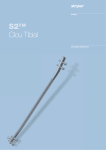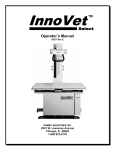Download HE425 Generator Manual - Spectrum Medical X
Transcript
P/N 8000-HE425 Revision: D, November 18, 2005 HE425 HE425 X-Ray Generator Installation, Operation & Service Manual HE425 X-Ray Generator Revision D Periodic Maintenance Revision History Revision A Date 03/15/2002 B 05/13/2002 C D 10/28/2004 11/18/2005 Description Initial release Small spot MA station changes, schematic value update and part number change. Remove text page 29. Upgraded to UL 60601 specifications and also upgraded schematics. In the event of a malfunction that has contributed or could contribute to a patient or operator injury, please contact: In North America Del Medical Imaging Corporation 50B North Gary Avenue Roselle, IL 60172 Tel: (847) 288-7000 Fax: (847) 288-7011 © 2002 Universal 11/18/05 page ii MANUAL IMPROVEMENT RECOMMENDATION We at Del Medical Imaging Corporation are most interested in improving the quality of the Technical Documentation we provide. Please identify improvements or corrections and fax them to our Technical Publications Department. Name________________________________________________ Dealership____________________________________________ Manual Part Number____________________________________ Device Name__________________________________________ Recommendation or Correction__________________________________________________ _____________________________________________________________________________ _____________________________________________________________________________ _____________________________________________________________________________ _____________________________________________________________________________ _____________________________________________________________________________ _____________________________________________________________________________ _____________________________________________________________________________ _____________________________________________________________________________ Technical Support (847) 288-7000 Fax (847) 288-7011 e-mail: [email protected] © 2002 Universal 11/18/05 page iii TABLE OF CONTENTS Revision History............................................................................................................................ ii Applicable Standards ....................................................................................................................... 1 Abbreviations................................................................................................................................ 2 INTRODUCTION.............................................................................................................................. 2 Use of this Manual........................................................................................................................ 2 Safety ........................................................................................................................................... 2 Maximum Permissible Dose (MPD) ............................................................................................. 3 Manufacturer’s Responsibility ...................................................................................................... 3 Radiation Protection ..................................................................................................................... 4 Monitoring of Personnel ............................................................................................................... 4 OPERATION .................................................................................................................................... 7 Control Panel Controls & Functions ............................................................................................. 7 Operating Procedure .................................................................................................................... 8 PRE INSTALLATION ..................................................................................................................... 10 Space Requirements .................................................................................................................. 10 Specifications ............................................................................................................................. 10 Maximum Ratings....................................................................................................................... 10 Input Power Requirements Line Voltage.................................................................................... 10 Line Regulation .....................................................................................................................................11 Required Wire Size ...............................................................................................................................11 Circuit Protection (Mains) ........................................................................................................... 11 Accuracy Statements.................................................................................................................. 11 kVp........................................................................................................................................................11 mA.........................................................................................................................................................12 Time ......................................................................................................................................................12 Compatibility ...............................................................................................................................12 Bucky Compatibility .............................................................................................................................12 Aux. Power Output................................................................................................................................12 INSTALLATION.............................................................................................................................. 14 Test Equipment .......................................................................................................................... 14 Unpacking................................................................................................................................... 14 H.V. Transformer ........................................................................................................................ 15 Control ........................................................................................................................................ 15 Access to Inside of Control ...................................................................................................................15 H.V. Transformer Connections................................................................................................... 15 Collimator Power ........................................................................................................................ 15 Magnetic Lock Power ................................................................................................................. 16 Bucky Connections..................................................................................................................... 16 Incoming Line Cable Connection ............................................................................................... 17 Line Voltage Adjustments........................................................................................................... 17 Tube Selection............................................................................................................................ 19 CALIBRATION ...............................................................................................................................20 MA Calibration ............................................................................................................................ 21 Standby Filament Current Adjustment ..................................................................................................21 Initial mA Calibration ...........................................................................................................................21 Space Charge Calibration ......................................................................................................................22 kVp Calibration ........................................................................................................................... 23 50 mA Station (small focal spot)...........................................................................................................24 75 mA Station (small focal spot)...........................................................................................................24 100 mA Station (small focal spot).........................................................................................................25 200 mA Station (large focal spot)..........................................................................................................26 300 mA Station (large focal spot)..........................................................................................................26 400 mA Station (large focal spot)..........................................................................................................26 © 2002 Universal 11/18/05 page iv THEORY OF OPERATION ............................................................................................................ 28 Turn ON sequence.................................................................................................................................28 KV Selection .........................................................................................................................................28 MA Selection.........................................................................................................................................28 Time Selection.......................................................................................................................................29 Calculation and Display of mAs............................................................................................................29 kVp Display...........................................................................................................................................29 Exposure Sequence................................................................................................................................30 Tube Protection .....................................................................................................................................31 SERVICE ADJUSTMENTS............................................................................................................ 32 SCHEMATICS................................................................................................................................ 33 DIAGNOSTICS .............................................................................................................................. 34 Troubleshooting SCR Block Gates........................................................................................................34 Troubleshooting Main SCR Gate Drive ................................................................................................34 Troubleshooting the Backup SCR Gate Drive.......................................................................................34 Renewal Parts................................................................................................................................ 36 PERIODIC MAINTENANCE .......................................................................................................... 37 Preventative Maintenance.......................................................................................................... 37 Cleaning Instruction:................................................................................................................... 37 Cleaning instruction ………………………………………………………………… ……… …….35 © 2002 Universal 11/18/05 page v HE425 X-Ray Generator Revision D Introduction Applicable Standards This X-ray generator complies with the following regulatory and design standards: FDA 21 CFR Subchapter J, UL60601-1, CSA C22.2 No. 601.1, EN60601-1, IEC 60601-1, IEC 60601-1-2, and IEC 60601-2-7. Degree of protection against harmful ingress of water: IPXO.Ordinary Type of protection against electric shock: Class I Mode of operation: 0.5% Duty Cycle. Equipment not suitable for use in presence of a flammable anesthetic mixture with air or with oxygen or nitrous oxide. Degree of protection against electric shock is Type B applied part . The function and intended application of this equipment is general radiography for human use. Definition of symbols Warning symbol used to indicate a potential hazard to operators, service personnel or to the equipment. It indicates a requirement to refer to the accompanying documentation for details. This symbol states that there is accessible Dangerous Voltage. This symbol states that this product is categorized as Type B. This symbol identifies the Protective Earth Terminal © 2002 Universal 11/18/05 page 1 HE425 X-Ray Generator Revision D Introduction Abbreviations mm cm Kg Lbs ºF ºC % hPa UL CE millimeter centimeter kilogram pounds degree Fahrenheit degree Celsius percent Hecto Pascal Underwriters Laboratories Communautés Européennes INTRODUCTION Use of this Manual Throughout the manual there are Note, Caution and Warning statements, which contain information to assist the user of this manual. The information may direct the user in the performance of a task or it may inform the user of a potentially hazardous situation. Each alert word is always used with only one specific type of information. The types of information contained in the statements are as follows: NOTE: Information, which assists the user of the manual in the performance of a task. It may provide the user with better methods of conducting the task, or it may point out conditions which could cause the system to fail to operate properly. CAUTION: Information, which alerts the user of the manual to situations that could result in damage to the equipment. WARNING: Information, which alerts the user of the manual to situations which could be hazardous to the health of the patient, the operator, the maintenance person or others. Safety It is vitally important that everyone associated with x-ray work is familiar with the recommendations of the Department of Health, National Bureau of Standards, and the National Council on Radiation Protection. The control of diagnostic medical x-ray equipment varies in detail from state to state. © 2002 Universal 11/18/05 page 2 HE425 X-Ray Generator Revision D Introduction However, in general, all of the states adhere strictly to the established recommendations of the NCRP. It is not practical to list all the relevant recommendations in this manual. Therefore, prior to operation, be sure that all personnel who are authorized to operate the x-ray system are familiar with the established regulations of the authorities named above. Also, they should be monitored to assure that they conform to the recommendations. Current sources of information include: • National Council on Radiation Protection Report No. 33 (Medical X-ray and Gamma-Ray Protection for Energies up to 1.0 MEV-Equipment Design and Use. National Bureau of Standards Handbook no. 76 (Medical X-Ray Protection up to Three Million Volts). Refer to NCRP Report No. 33. • Current recommendations of the International Committee on Radiation Protection. Although x-ray radiation is hazardous, x-ray equipment does not pose any danger when it is properly used. Be certain that all service and operating personnel be properly informed on the hazards of radiation. Also, those responsible for the system must understand the safety requirements for x-ray operation. Study this manual and the manuals for each component in the system to become aware of all the safety and operational requirements. Maximum Permissible Dose (MPD) Various studies of the effects of x-ray radiation have provided a foundation for establishing the maximum permissible does (MPD) of x-ray radiation. The results of these studies have been used by the NCRP and the ICEP to develop recommendations for MPD. ICRP recommends that the MPD to the most critical organs (heart, lungs, liver, kidney, brain, etc.) accumulated at any age shall not exceed five rems multiplied by the number of years beyond 18: MPD = 5 X (N - 18) rems where N age in years However, in no case shall the exposure exceed three (3) rems in any period of 13 consecutive weeks. For hands, forearms, feet and ankles, the recommended MPD is 75 rems in any one year. Manufacturer’s Responsibility Although this equipment incorporates protection against x-ray radiation other than the useful beam, practical design cannot provide complete protection. Equipment design does not compel the operator or his assistants to take adequate precautions. Nor does it prevent the possibility of improper use which © 2002 Universal 11/18/05 page 3 HE425 X-Ray Generator Revision D Introduction may result in authorized or unauthorized persons carelessly, unwisely, or unknowingly exposing themselves or others to direct or secondary radiation. Allow only authorized, properly trained personnel to operate this equipment. Be certain that all personnel authorized to use the equipment are aware of the danger of excessive exposure to x-ray radiation. This equipment is sold with the understanding that the manufacturer, its agents and representatives, do not accept any responsibility for over exposure of patients or personnel to x-ray radiation. Furthermore, the manufacturer does not accept any responsibility for overexposure of patients or personnel to x-ray radiation generated by this equipment which is a result of poor operating techniques or procedures. Also, no responsibility will be assumed for any machine that has not been serviced and maintained in accordance with the system technical manual, or which has been modified or tampered with in any way. Radiation Protection Because exposure to x-ray radiation may be damaging to health, use great care to provide protection against exposure to the primary beam. Some of the effects of x-ray radiation are cumulative and may extend over a period of months or years. The best safety rule for x-ray operators is - Avoid exposure to the primary beam at all times. Any object in the path of the primary beam produces secondary (scattered) radiation. The intensity of the secondary radiation is dependent upon the energy and intensity of the primary beam and on the atomic number for the for the objector material struck by the primary beam. Secondary radiation may be of greater intensity than that of the radiation reaching the film. Take protective measures to safeguard against it. An effective protective measure is the use of lead shielding. To minimize dangerous exposure, use such items as movable lead screens, lead impregnated gloves and lead impregnated aprons. While servicing or operating x-ray equipment, do not expose hands, wrists, arms or other parts of the body to the primary beam. Monitoring of Personnel Monitoring of personnel to determine the amount of radiation to which they have been exposed provides a valuable cross-check to determine whether or not safety measures are adequate. It may reveal inadequate or improper radiation protection practices and potentially serious radiation exposure situations. © 2002 Universal 11/18/05 page 4 HE425 X-Ray Generator Revision D Introduction The most effective method of determining whether or not the existing protective measures are adequate is the use of instruments to measure the exposure in RADS. This measurement should be taken at all locations where the operator, or any portion of his body, may be during exposure. Exposure must never exceed the accepted tolerable dose. A common method of determining whether personnel have been exposed to excessive radiation is the use of film badges. These are x-ray sensitive film enclosed in a badge which incorporates metal filters of varying degrees of transparency to x-ray radiation. Even though this device only measures the radiation, which reaches the area of the body on which it is worn, it does furnish an indication of the amount of radiation received. © 2002 Universal 11/18/05 page 5 HE425 X-Ray Generator Revision D Introduction Grounding Information The figure below shows a typical interconnected x-ray system. It is comprised of: 1. Tube Stand 2. Collimator 3. X-Ray Tube 4. Float-Top Table 5. Wall Stand 6. X-Ray Generator 7. Collimator Power Supply All of these components are grounded to a common bus according to national and local electrical codes. Also, all of the components should comply with UL 60601 Standards. 5 Buss Ground 1 3 2 4 6 7 © 2002 Universal 11/18/05 page 6 HE425 X-Ray Generator Revision D Operation OPERATION Control Panel Controls & Functions 10 11 6 5 4 1 7 2 3 8 9 1. ON Button - Pushing this button will turn the unit ON. 2. OFF Button - Pushing this button will turn the unit OFF. 3. BUCKY Switch - Selecting Table or Wall will allow the respective optional Bucky to energize when an exposure is initiated. Selecting Off will inhibit either Bucky from energizing when an exposure is initiated. 4. Minor kVp - This rotary switch selects kVp in 1-2 kVp increments and is used in conjunction with the Major kVp switch to select the desired kVp. 5. Major kVp - This rotary switch selects kVp in approximately 10 kVp increments and is used in conjunction with the Minor kVp switch to select the desired kVp. 6. mA Selector - This rotary switch selects the desired mA level with the corresponding small or large focal spot. S after the number indicates small focal spot and L indicates large focal spot. 7. Time Selector - This rotary switch selects the desired timer setting. 8. PREP Button - Pushing and holding this button will initiate the Prepare cycle. The anode in the x-ray tube begins to spin and the filament in the © 2002 Universal 11/18/05 page 7 HE425 X-Ray Generator Revision D Operation tube is elevated to the proper brightness for the mA selected. When the Prepare cycle has successfully completed, in 1-2 seconds, the PREP button will illuminate. Releasing the switch will terminate the Prepare cycle. Note: If the PREP cycle does not begin when the button is pushed, you may have previously encountered an error condition which is inhibiting the PREP function. Turning the power off and on once will reset this circuit, if an error has occurred. 9. EXPOSE Button - Pushing and holding this button while the PREP button is depressed and illuminated will initiate the exposure. The exposure duration shall end either at the pre-selected time set by the Time selector or when you release either the EXPOSE or PREP buttons; whichever comes first. This button shall illuminate during the duration of the exposure. 10. mAs Digital Readout - Provides a pre-exposure indication of the mAs, as calculated by multiplying the selected values for mA and Time. This indicator is also used as an error message center if an improper technique is selected. If a technique is selected that exceeds the power rating of the x-ray tube, the indicator shall read '-E-' and the unit will not allow the Prep cycle to be initiated. To clear the error, you need to reset the technique. 11. kVp Digital Readout - Provides a pre-exposure indication of the kVp selected. The display is self compensated for minor variations in the input line voltage. Operating Procedure 1 Push the ON button to energize the unit. If the unit does not turn on, verify that the shut-off switch on the wall and the main circuit breaker is on. The generator and x-ray tube should always be allowed to warm up for at least twenty minutes prior to its planned use, to allow for proper temperature stabilization, which will ensure accurate performance and prolong the life of the tube. 2 Select the desired mA station. Ensure that mA is selected prior to adjusting the kVp to its final value. Changing mA stations will affect the kVp indication. 3 Select the required time station and verify that the indicated mAs is equal to the product that you desire. If not, readjust mA and Time accordingly. 4 Select the desired kVp. 5 Depress and hold the PREP button. © 2002 Universal 11/18/05 page 8 HE425 X-Ray Generator Revision D Operation 6 When the PREP button illuminates, and you are ready to initiate an exposure; depress and hold the EXPOSE button until you hear the audible beep and see the light in the EXPOSE button extinguish. 7 If a mA overload condition is encountered during the exposure, an internal detection circuit will immediately terminate the exposure and inhibit any further exposures. The generator can be reset by pressing the power off button and waiting for at least ten seconds before pressing the power on button. 8 Release the PREP and EXPOSE buttons. 9 Push the OFF button to turn the unit off. © 2002 Universal 11/18/05 page 9 HE425 X-Ray Generator Revision D Pre Installation PRE INSTALLATION Space Requirements Specifications Maximum Ratings Maximum output: Duty Cycle: 400 mA @ 100 kVp 300 mA @ 125 kVp 153 amps momentary on a 240 VAC line. (100 kVp @ 400 mA.) 168 amps momentary on a 230 VAC line. (100 kVp @ 400 mA.) 0.5% Standby Current: 3 Amps. Line current at max. rating (60Hz.): Line current at max. rating (50 Hz.) External Heat Generation: 2320BTU Output P(w) = 0.707V(kvp) * I(mA) Input Power Requirements Line Voltage For Model HE425: Nominal 240 VAC, 194 - 277 VAC, 60 HZ, Single Phase (specified at time of purchase) For Model HE425/50HZ: Nominal 230 VAC, 194 - 277 VAC, 50 HZ, Single Phase (specified at time of purchase) Environment and Conditions for Transport/Storage © 2002 Universal 11/18/05 page 10 HE425 X-Ray Generator Revision D Pre Installation Transit/Storage Temperature: -40degC to +70degC Operating Temperature: +10degC to +35degC. Relative Humidity………….. 10-100% Atmospheric pressure…….. 500hPa to1060hPa Apparent Resistance of Supply Mains: 0.09 Ohm Line Regulation The 240 VAC power line, typically a 100-amp service, must have a regulation of < 5% when operated at a momentary load of 140 amps. Required Wire Size The following Table lists the wire size for various distances from the power disconnect near the control to the main distribution panel. LINE VOLTAGE 240 VAC Single Phase 208 VAC Single Phase WIRE SIZE FOR THE FOLLOWING DISTANCES: 0-50' #2 #2 50'-100' #00 #00 100'-200' 250 mcm 250 mcm Circuit Protection (Mains) National and local electrical codes require installation of a disconnecting switch or circuit breaker, rated for at least 50% of the input current required for the maximum momentary rating of the unit, which must be placed in a location readily accessible from the x-ray control. A common disconnect switch box is a 100 amp surface mounted safety disconnect switch. It is required that UL listed current limiting current 50A, 250V time delayed fuses or double pole circuit breaker be provided for both lines of Generator power. Accuracy Statements The following statements assume kVp is measured with an invasive bleeder tank, such as a Dynalyzer, with an oscilloscope to view the actual kv peaks; time is measured with a similar device as kVp to allow the counting of the actual pulses; and that mA is measured by an invasive average sensing mA meter placed in the center leg of the high voltage secondary. kVp kVp Range: 40 to 125 kVp Resolution: 1 to 2 kV in steps Accuracy: +/- 10% of indicated value © 2002 Universal 11/18/05 page 11 HE425 X-Ray Generator Revision D Pre Installation mA Selections: Accuracy: Small Spot: 50, 75, 100 mA Large Spot: 200, 300, 400 mA +/- 15% Time Selections: Accuracy: 23 selections, between 1/120 second to 6 Seconds +/- 1/120th second through 1/2 second and +/- 1/60 second above 1/2 second Compatibility This 402.100.00 control is only compatible with the 402.501.00 high voltage generator. This unit is compatible with the following x-ray tubes: Toshiba E7239 (1X2mm) Toshiba E7242 (0.6X1.5mm) Varian RAD 8 (1X2mm) Varian RAD 13 (1X2mm) Bucky Compatibility Maximum Number of Buckys: Control Type: 2 120 VAC Aux. Power Output Locks: Collimator: 24 VDC, fused at 2 Amps 24 VAC, fused at 8 Amps © 2002 Universal 11/18/05 page 12 HE425 X-Ray Generator © 2002 Universal Revision D 11/18/05 Installation page 13 HE425 X-Ray Generator Revision D Calibration INSTALLATION Warning: The instructions in this manual are intended for qualified personnel only. Test Equipment • Digital VOM • Dynalyzer with trigger level set at 90% or HV voltage divider tank • Storage Oscilloscope • mAs Meter Preliminary Site Inspection Before beginning installation, inspect the x-ray room to verify compliance with specifications for the following: • • • Incoming Line Mains Switch Space Requirements Unpacking Upon receipt of the equipment, inspect all shipping containers for signs of damage. If damage is found, notify the carrier or his agent immediately. When the equipment is unpacked; inspect all pieces for visible damage. If any damaged parts are detected, repair or order replacements without delay to prevent unnecessary delay in installation. Before beginning the installation, verify the following: • • • • All hardware is secure All internal wiring is secure Configuration is correct All items on the customer order are included in the system. © 2002 Universal 11/18/05 page 14 HE425 X-Ray Generator Revision D Calibration H.V. Transformer Locate the HV transformer in its final location. Open the inspection port and ensure that the dielectric oil level of the unit is approximately 1/2" from the top of the unit. If necessary, add Shell Diala-AX oil as required. (Shell Diala-AX does not contain any PCB’s) Control Locate the control close to its final location leaving some room behind it to facilitate installing necessary cabling. Access to Inside of Control Remove the two screws at the bottom of the front access panel and pull the bottom forward. To gain access to the top portion of the control, remove the two screw/alignment pin assemblies at the sides of the chassis that hold the top portion of the access panel in place. Swing the upper portion of the control upwards. H.V. Transformer Connections The two control-transformer cables for the H.V. primary and the auxiliary transformer, are pre-wired to the control at the factory. Connect the cables to the H.V. transformer according to the respective markings of each wire. Caution: The terminal pins on the high voltage connectors are extremely delicate and can easily be damaged. Ensure that they are straight and that the split ends of the pins are slightly open. Use a thin metal blade to open them slightly, if necessary. Clean the HV terminals carefully, using a clean, lint-free cloth and a light solvent, such as alcohol, before applying the vapor-proofing compound. Use a clean non-conducting applicator to coat each cable plug with vaporproofing compound. Apply a one half inch high cone of the compound to the end of each insulator before inserting it into the high voltage socket. You may also apply a small amount of the compound to the threads of the connector socket of the strain relief flange, to facilitate easier threading of the hardware. Collimator Power For 24 VAC collimator power connect the collimator power cable to TS3-1 and TS3-3. © 2002 Universal 11/18/05 page 15 HE425 X-Ray Generator Revision D Calibration Magnetic Lock Power For 24 VDC lock power connect lock supply cable to TS3-5 and TS3-7. Bucky Connections The control is shipped with a jumper in place to allow operation without a Bucky. If a Bucky is to be used, remove the jumper between TS3-18 and TS3-19 and connect the Bucky as follows: BUCKY CONNECTIONS HE425 Control Function Bucky Exp Contacts (24 VAC) Bucky Exp Contacts (24 VAC) Bucky Drive (115 VAC) Bucky Drive Return (115 VAC) Bucky Home (115 VAC) © 2002 Universal Table Wall Midwest Bucky Progeny/ Liebel Bucky Liebel Bucky (older models) TS3-19 TB1 TS3-20 WB1 B1 1 B1 TS3-17 TB2 TS3-18 WB2 B2 2 B2 TS3-15 TB3 TS3-16 WB3 B3 3 B3 TS3-13 TB3 TS3-14 WB4 B4 N B4 TS3-10 TB8 TS3-11 WB8 B8 L B8 11/18/05 page 16 HE425 X-Ray Generator Revision D Calibration Incoming Line Cable Connection WARNING: Ensure that the main power safety disconnect is OFF prior to connecting or disconnecting the line cable. Measure the incoming line voltage at the disconnect switch (wall panel) before connecting the power cable (part # 3480-0141) that will go to the console. Connect the wires from the incoming line cable marked L1 and L2 to terminals 1 and 2 of TS5. Connect the GROUND lead from the same cable to the CHASSIS GROUND lug, located on the bottom panel of the control console, near TS5. Line Voltage Adjustments Terminals on TS1 and TS2 are provided for coarse and fine adjustments of the incoming line voltage. Measure the line voltage at the disconnect switch and relocate wires marked "ALVF" and “ALVC”, according to the following chart: Line Voltage 194 198 202 207 211 214 218 221 223 227 230 234 238 241 243 247 250 277 Refer to schematic 120-5022 configuration of the autoformer. © 2002 Universal ALVC ALVF TS1-5 TS1-5 TS1-5 TS1-4 TS1-4 TS1-4 TS1-4 TS1-4 TS1-3 TS1-3 TS1-3 TS1-3 TS1-3 TS1-3 TS1-2 TS1-2 TS1-2 TS1-1 TS2-6 TS2-7 TS2-8 TS2-4 TS2-5 TS2-6 TS2-7 TS2-8 TS2-3 TS2-4 TS2-5 TS2-6 TS2-7 TS2-8 TS2-3 TS2-4 TS2-5 TS2-7 for additional 11/18/05 details regarding voltage page 17 HE425 X-Ray Generator Revision D Calibration Ensure that the incoming line voltage adjustment for the autotransformer is correct and that all connections are tightly secured before connecting the incoming line cable to the safety disconnect switch on the wall. All of the components used with the generator (X-ray tube, collimator, genrator, etc.) must comply with UL 60601 Standards. © 2002 Universal 11/18/05 page 18 HE425 X-Ray Generator Revision D Calibration Tube Selection The HE425 generator is compatible with 4 different x-ray tubes. To ensure that the proper tube protection profile for your tube has been selected, refer to the chart below and install jumpers in JP1 on the main control board, as indicated: X- RAY TUBE Toshiba E7239 (1 X 2 mm) Toshiba E7242 (0.6 X 1.5 mm) Varian RAD 13 (1 X 2 mm) Varian RAD 8 (1 X 2 mm) Position 0 installed Position 1 Position 2 installed Installed Installed Verify that jumper (J8) on rotor control board are set for the type of X-ray tube you are using according to Table and Figure on below. X- Ray Housing Type Varian RAD 8 (1 X 2 mm) Varian RAD 13 (1 X 2 mm) Toshiba E7239 (1 X 2 mm) Toshiba E7242 (0.6 X 1.5 mm) Position of jumper J8 Middle and lower (2 in Figure below) Middle and lower (2 in Figure below) Upper and middle (1 in Figure below) Upper and middle (1 in Figure below) 2 1 © 2002 Universal 11/18/05 page 19 HE425 X-Ray Generator Revision D Calibration Rotor Cable Connections The wires of the rotor cable are labeled T5, T6, MAIN, PHASE & COM. Connect them as shown below. MAIN PHASE COM T5 T6 CALIBRATION To ensure accuracy, always allow the generator to warm up for at least twenty minutes prior to performing these calibration procedures. If the unit is turned off and allowed to cool at any point in the process of calibration, it must be warmed up again before proceeding. WARNING: Exercise extreme caution with regard to the temperature of the x-ray tube during the calibration procedures. You must allow sufficient time for the anode of the tube to cool between exposures, in order to prevent permanent damage to the x-ray tube. Refer to the cooling charts for the anode and tube housing in the documentation that accompanied your x-ray tube. The installer should read and understand the information provided with the x-ray tube prior to making any x-ray exposures. © 2002 Universal 11/18/05 page 20 HE425 X-Ray Generator Revision D Calibration It is recommended that the measuring equipment connected to the x-ray system should be used to monitor mA and kVp throughout the entire calibration procedure to reduce the chances of misleading test results. mA Calibration Connect a Dynalyzer or a mA meter to perform the following procedure. If no Dynalyzer is available, mA may also be measured by removing the jumper between the “MA-" and "MA+” terminals 5 and 6 of TS4, and connecting a DC mA meter between those terminals. Caution: Be sure to replace this jumper after removing the mA meter, when calibration has been completed. Standby Filament Current Adjustment Measure the filament secondary current during standby with a Dynalyzer and verify that the filament secondary current is in the range of 3.0 - 3.2 amps RMS. If required, adjust the slider band on resistor RB. If no Dynalyzer is available, the field engineer may adjust the filament by eye, adjusting resistor RB so that a dull glow just begins to show on the selected filament. Initial mA Calibration You must first set the kV Major and Minor switches in a position that produces no voltage across the space charge transformer. This will allow the engineer to calibrate the base value all of the individual mA settings, with no additional effect from the space charge compensation voltage. At this time, the value of the indicated kVp is not important. • • • Set the kVp Major and Minor switches fully counter clockwise. Rotate the kVp Major switch six audible clicks clockwise. You may now calibrate each of the mA stations for its indicated value (50, 75, 100, 200, 300, and 400 mA) at this kVp setting, by adjusting the respective bands on resistors RXL and RLS. The leads connected to the © 2002 Universal 11/18/05 page 21 HE425 X-Ray Generator • • • Revision D Calibration bands of these resistors are marked with numbers which correspond to the mA stations. Moving any one of these bands to the right increases the mA for the corresponding mA station. Select a time setting of 0.1 second. If you are using an mA meter, select a longer time, such as 1 second, to allow the meter reading to stabilize properly. Make a series of exposures at each of the available mA stations and adjust resistor RXL or RXS as necessary to obtain the desired mA. When all of the mA stations have been calibrated for their proper base value, you may continue with the space charge calibration procedure. Space Charge Calibration Space charge compensation for all mA stations is adjusted with resistor RSC. The leads connected to the bands of RSC are also marked with numbers which correspond to the same mA stations. Moving any one of these bands to the right causes a decrease of mA at high kVp levels and an increase of mA at low kVp levels for the corresponding mA station. This is commonly referred to as space charge compensation. Normal tracking of mA over the entire range of kVp will result in mA values slightly higher than selected near 80 kVp and mA values slightly lower than selected levels at the high and low ends of the kVp range (125 and 50). See chart below: 1. Select the 50 mA station, 80 kVp, and 0.1 second. 2. Select 50 kVp and note the mA produced. © 2002 Universal 11/18/05 page 22 HE425 X-Ray Generator Revision D Calibration 3. Select 120 kVp and note the mA produced. 4. If the mA produced at 120 kVp is higher than the mA produced at 50kVp, move the respective band of RSC to the right. If lower, move the band to the left. 5. Repeat steps (1) through (4) until no further adjustments are necessary. 6. Check mA tracking from 50 to 120 kVp and fine tune as required. The unit must track within ± 10 % of the selected mA value. 7. Repeat steps (1) through (6) for the remaining mA stations. kVp Calibration The control has an adjustable kVp Meter Compensation Circuit that adjusts the displayed value of the kVp meter to compensate for the loading effects of different mA selections. This circuit consists of two separate 'offset' and "slope" potentiometer adjustments for each mA station, for a total of twelve pots on the board. These adjustment pots are located on the KV Adjust PCB, which is mounted above the Main Control PCB in the top section of the control, beneath the control panel lid. The first group of potentiometers on the left side of the board are the 'Offset' adjustments and the second group of potentiometers on the right side are the 'Slope' adjustments. The pots are labeled MA1 thru MA6 on both sides of the board, which correspond to 50 mA, 75 mA, 100 mA, 200 mA, 300mA and 400 mA, respectively. The "Offset' adjustment raises or lowers the reading of the kVp meter the same amount at all points of the kVp range for the selected mA station. See illustration below: The 'Slope' adjustment changes the reading of the kVp meter a greater amount at the higher kVp settings than at the lower kVp settings for the same respective mA station. See illustration below: © 2002 Universal 11/18/05 page 23 HE425 X-Ray Generator Revision D OFFSET KV DISPLAY Calibration SLOPE KV DISPLAY PRIMARY VOLTS N.L. PRIMARY VOLTS N.L. NOTE: In order to accurately compare the actual measured kVp of an exposure to the indicated kVp on the display, the tube current must first be accurately calibrated. Failure to do so will result in inaccurate kVp. 50 mA Station (small focal spot) 1) Select 50 mA and 50 kVp. While monitoring the mA and kVp outputs, compare the measured kVp to the kVp meter's pre-exposure indication. 2) Adjust the 50 mA KV Offset pot, MA1, until the kVp meter's pre-read indication matches the measured kVp output. 3) Select 120 kVp. Make an x-ray exposure and adjust the KV Slope pot "MA1" until the kVp meter's pre-exposure indication matches the measured kVp output. Repeat steps 1, 2, and 3 until no further adjustments are necessary. 4) Check final kVp meter tracking over the entire kVp range. Under normal conditions the kVp meter's indication will not deviate from the measured kVp output by more than 5 kVp. 75 mA Station (small focal spot) 1) Select 75 mA and 50 kVp. While monitoring the mA and kVp outputs, compare the measured kVp to the kVp meter's pre-exposure indication. 2) Adjust the 75 mA KV Offset pot, MA2, until the kVp meter's pre-read indication matches the measured kVp output. 3) Select 120 kVp. Make an x-ray exposure and adjust the KV Slope pot "MA2" until the kVp meter's pre-exposure indication matches the measured kVp output. Repeat steps 1, 2, and 3 until no further adjustments are necessary. © 2002 Universal 11/18/05 page 24 HE425 X-Ray Generator Revision D Calibration 4) Check final kVp meter tracking over the entire kVp range. Under normal conditions the kVp meter's indication will not deviate from the measured kVp output by more than 5 kVp. 100 mA Station (small focal spot) 1) Select 100 mA and 50 kVp. While monitoring mA and kVp output, compare the measured kVp to the kVp meter's pre-exposure indication. 2) Adjust the 100 mA KV Offset pot, MA3, until the kVp meter's pre-read indication matches the measured kVp output. 3) Select 120 kVp. Make an x-ray exposure and adjust the KV Slope pot "MA3" until the kVp meter's pre-exposure indication matches the measured kVp output. Repeat steps 1, 2, and 3 until no further adjustments are necessary. 4) Check final kVp meter tracking over the entire kVp range. Under normal conditions the kVp meter's indication will not deviate from the measured kVp output by more than 5 kVp. © 2002 Universal 11/18/05 page 25 HE425 X-Ray Generator Revision D Calibration 200 mA Station (large focal spot) 1) Select 200 mA and 50 kVp. While monitoring the mA and kVp outputs, compare the measured kVp to the kVp meter's pre-exposure indication. 2) Adjust the 200 mA KV Offset pot, MA4, until the kVp meter's pre-read indication matches the measured kVp output. 3) Select 120 kVp. Make an x-ray exposure and adjust the KV Slope pot "MA4" until the kVp meter's pre-exposure indication matches the measured kVp output. Repeat steps 1, 2, and 3 until no further adjustments are necessary. 4) Check final kVp meter tracking over the entire kVp range. Under normal conditions the kVp meter's indication will not deviate from the measured kVp output by more than 5 kVp. 300 mA Station (large focal spot) 1) Select 300 mA and 50 kVp. While monitoring the mA and kVp outputs, compare the measured kVp to the kVp meter's pre-exposure indication. 2) Adjust the 300 mA KV Offset pot, MA5, until the kVp meter's pre-read indication matches the measured kVp output. 3) Select 120 kVp. Make an x-ray exposure and adjust the KV Slope pot "MA5" until the kVp meter's pre-exposure indication matches the measured kVp output. Repeat steps 1, 2, and 3 until no further adjustments are necessary. 4) Check final kVp meter tracking over the entire kVp range. Under normal conditions the kVp meter's indication will not deviate from the measured kVp output by more than 5 kVp. 400 mA Station (large focal spot) 1. Select 400 mA and 50 kVp. While monitoring the mA and kVp outputs, compare the measured kVp to the kVp meter's pre-exposure indication. 2. Adjust the 400 mA KV Offset pot, MA6, until the kVp meter's pre-read indication matches the measured kVp output. 3. Select 100 kVp. Make an x-ray exposure and adjust the KV Slope pot "MA6" until the kVp meter's pre-exposure indication matches the © 2002 Universal 11/18/05 page 26 HE425 X-Ray Generator Revision D Calibration measured kVp output. Repeat steps 1, 2, and 3 until no further adjustments are necessary. 4. Check final kVp meter tracking over the entire kVp range. Under normal conditions the kVp meter's indication will not deviate from the measured kVp output by more than 5 kVp. © 2002 Universal 11/18/05 page 27 HE425 X-Ray Generator Revision D Theory of Operation THEORY OF OPERATION Turn ON sequence The incoming line voltage is passed through K1, the main line contactor, to the inputs of the main autotransformer that have been selected according to the measured line voltage. Pressing the ON switch on the operator’s control activates the line contactor. The L3/T3 terminal of the line contactor is used to latch the incoming line voltage to the coil of the contactor, through the Normally Closed contacts of the OFF switch. Pressing the OFF switch interrupts the voltage, opening the latching contact and deactivating the contactor. When the line contactor is closed the incoming line voltage is applied to the autotransformer, which then presents voltages at all of its output taps. 120 VAC, fused at 8 Amps, through fuse F2, is then applied to the Main control board power supply transformer (T2), through fuse F1 and connector H12. The output from T2 is rectified and supplied to linear regulators, which produce + 12 VDC, +5 VDC, and -5 VDC, which is used to operate the main control board circuitry, as well as the 7 segment displays for kVp and mAs. Fuse F2 is also used to supply 117 VAC for all auxiliary components, such as the Buckys, the Stator Drive PCB Power Supply. The Stator Drive PCB has onboard primary transformer fusing for its power supply, as well as a 10 Amp fuse for the rotor boost voltage. kV Selection Tapped voltages from the autotransformer are selected by the kVp Major and minor switches and connected to the two SCR blocks. This voltage is also routed to the space charge transformer (T3). The outputs from KV Minor tape switch is sent to the main control board, where it is scaled and rectified and used to provide the raw drive for the kVp display, after being processed through the kV adjust board and the main control board. mA Selection A three-deck six position switch on the operator’s console is used to manually select the tapped voltages from the space charge resistor and resistors RXL and RXS, to provide voltage for the primary of the filament drive transformers in the high tension tank. The third deck of this switch is used to provide selection data to the main control board, through connector H11. This data is used to select © 2002 Universal 11/18/05 page 28 HE425 X-Ray Generator Revision D Theory of Operation offset and slope compensation from pots on the kV Adjust Board and as addressing information for mAs calculations. Time Selection 23 available time stations may be selected using the Time Selector switch on the front panel of the operator’s control. The output from this switch is a five bit binary encoded word, which is used to provide addressing information to U27, to decode the actual exposure time, and to U25, to be used for mAs calculations. Calculation and Display of mAs Address data from the time selection and mA switches is used by U25 to lookup values of mAs, which are then output to a group of selectable latches (U23-A,B and U29-A), which feed into a common bus to a seven segment display driver (U22). Each of these latches holds one of the three digits that will be sent to the mAs display, and they are enabled sequentially, in time with the selection of the individual numbers on the front panel of the display. kVp Display The voltage that has been selected using the kV Major and Minor switches, is fused in the lower portion of the cabinet and then sent to the main control board, at connector H2. Caution: This sample voltage may range between 80 to 300 VAC, depending upon the value of kVp that has been selected. Although this voltage has been fused for safety, the field service engineer should be aware of the potential hazards for shock and component damage. Use appropriate care when inspecting this portion of the board while the unit is energized. This voltage is stepped down at T3, and then it is scaled and rectified at U2, before being sent to the KV Adjust board, where it is compensated for the selected mA, using selected potentiometers to attenuate the signal and provide the desired amount of DC offset to compensate for voltage drop under load. The compensated kV signal is then fed to a voltage to frequency converter (U4), which converts the analog voltage to a pulse train, which varies between approximately 3 to 5 KHz, depending on the selected kV. This pulse train is fed to U14, which is clocked at 6 Hz by U9. This clocking action reads out the stored © 2002 Universal 11/18/05 page 29 HE425 X-Ray Generator Revision D Theory of Operation value of the register inside U14 and then resets it. In this manner, the voltage is converted into proportionate pulses, which are counted and displayed again as voltage (kVp). This metering system is self-compensating for variations in the incoming line, which eliminates the need for manual line compensation. Exposure Sequence The exposure sequence begins by depressing the PREP switch on the operator’s console. This provides 120 VAC to the stator drive PCB, which closes the K3 relay, switching the primary filament voltage from standby to the boost level, as selected by the mA switch, and providing power to the space charge transformer. At the same time, relay K1 on the stator drive PCB is also activated, which provides the 240 VAC boost voltage to the stator of the x-ray tube. At the end of a 1.2 to 1.5 second delay, which is timed on the stator drive PCB, relay K4 closes, lighting the ready light behind the PREP switch and enabling the 24 VDC voltage that will be used to initiate the actual exposure on the main control board (connector H4). At this time, relay K1 opens and K2 closes, removing the 240 VAC boost from the stator and applying the 50 VAC run voltage. When no Buckys are selected, the 24 VDC signal is routed through the exposure switch to connector H4 through the normally closed contacts of the Bucky Enable relay (K5). If either Bucky has been selected, this voltage activates the Bucky drive relay, which energizes the appropriate Bucky, and the 24 VDC signal is then sent through the B1 and B2 contact closures of that Bucky to connector H4. On the main control board, the 24 VDC signal activates opto coupler OC2, which sends a signal through several gates of U32, setting the exposure latch of U21 to the active state, and passing the exposure release signal along through U7-B. This signal activates command to freeze the kVp display during the exposure, as well as enabling the 120 Hz pulse train at U8-A, which is divided to 60 Hz at U8A and used to clock U28, a binary counter that feeds its outputs to a set of binary comparators (U24, 26, and 30) which compare the desired time against the elapsed time of the exposure and terminate the exposure by resetting the exposure latch. The same pulse train from U8-A also provides pulses through a network of transistors (Q1, 2, 3), which provide pulses to the gates of the main SCR block. The exposure release signal also activates the audible alert and the BU SCR gate drive relay (K1-B), which arms the BU SCR for the exposure. When counter U28 reaches the desired number of counts, the binary comparators are satisfied, and a signal is released to terminate the exposure, by resetting the exposure latch. The generator is capable of beginning another © 2002 Universal 11/18/05 page 30 HE425 X-Ray Generator Revision D Theory of Operation exposure by releasing and pressing the exposure switch again, after an exposure has timed out properly, as long as the PREP switch has not been released. Additionally, there is a voltage detection circuit (opto coupler OC1) on the main control board, which senses the presence of line voltage across the BU SCR, which would indicate a failure of the main SCR. This circuit will produce a signal which can also hold the reset of the exposure latch, disabling the initiation of any exposures and lighting LED 4, the SCR FAIL LED. Tube Protection EPROM U25 is also used to implement the tube protection profile of the selected x-ray tube, by looking up the profile from a series of addressable lookup tables in its memory. Address information for time, mAs, and kVp are fed into this EPROM, along with address information from the jumpers at JP1, which are used to identify the tube type in use. If the selected technique is beyond the range of the tube protection profile, the LIMIT bit from pin 3 of U25 will be activated, which will inhibit any exposures until a proper technique has been selected. Additionally, this EPROM will generate the error message “-E-“, which will be displayed in the mAs display until the technique is within the appropriate limits for the tube. © 2002 Universal 11/18/05 page 31 HE425 X-Ray Generator Revision D Service Adjustments SERVICE ADJUSTMENTS The field service engineer is responsible for the preventative maintenance of the unit. Under normal circumstances, these procedures will have already been covered in the Calibration and Periodic Maintenance chapters of this manual. Additional information for the theory of operation and troubleshooting of this generator may be found in the Theory and Diagnostics chapters of this manual. Information related to the identification of replacement parts for this generator may be found in the Renewal Parts chapter of this manual. © 2002 Universal 11/18/05 page 32 HE425 X-Ray Generator Revision D Schematics SCHEMATICS Drawing number Description 034-5076 Interconnect diagrams for HE425 generator and various Tube/Wallstands Overall Control Wiring Diagram Schematic, Main Control PCB Schematic – KV Adjust PCB Schematic, HT Transformer Assy. 3560 Schematic, Rotor Control PCB 120-5022 124-5090 482.101.06S 482.501.01S 124-5076S # Sheets Current Rev. 2 1 2 1 1 1 See Config. table below 1 1 2 2 2 Configuration – Schematic Match Table Tubestand Model Collimator Model Wallstand/ Table Model Refer to Drawing # FMTS Tubestand K860 Floor-Ceiling Mounted Tubestand MC Series MC Series RT100/3546E 3546E 034-5076S7 034-5076S11 © 2002 Universal 11/18/05 Current Rev. 2 1 page 33 13 14 15 12 1 5 2 4 X0 X1 X2 X3 X4 X5 X6 X7 8 R91 VCC A B C OUT EN VEE 16 11 10 9 3 6 7 74HC4051 392K T3 SEE NOTE 1 13 14 15 12 1 5 2 4 R92 392K X0 X1 X2 X3 X4 X5 X6 X7 8 16 VCC A B C OUT EN VEE 11 10 9 3 6 7 VCC RB7 RB6 Vpp VCC VCC VCC C100 GND R100 10k 012 04 05 06 07 00 01 02 03 MCLR/Vpp RA0/AN0 RA1/AN1 RA2/AN2 RA3/AN3 RA4 RA5/AN4 RE0 RE1 RE2 OSC1/RA7 OSC2/RA6 RC0 RC1 RC2 RC3/SCK RD0/PSP0 RD1/PSP1 ZTX792A H100 .1uF RB7/PGD RB6/PGC RB5/AN13/CCP3 RB4/AN11 RB3/AN9 RB2/AN8 RB1/AN10 RB0/INT/AN12 RD7/PSP7 RD6/PSP6 RD5/PSP5 RD4/PSP4 RC7/RX/DT RC6/TX/CK RC5/SDO RC4/SDI/SDA RD3/PSP3 RD2/PSP2 R103 ZTX792A 1K VCC R104 ZTX792A 1K Q102 R101 1K MMSD LED100 MNSD MLSD U101 1 2 3 4 5 6 7 8 9 PIC16F777 H8 Q101 40 39 38 37 36 35 34 33 30 29 28 27 26 25 24 23 22 21 VSS 08 09 010 011 1 2 3 4 5 6 7 8 9 10 13 14 15 16 17 18 19 20 1K Q100 VDD VDD U100 32 R102 IN1 IN2 IN3 IN4 IN5 IN6 IN7 IN8 RN100 18 17 16 15 14 13 12 11 OUT1 OUT2 OUT3 OUT4 OUT5 OUT6 OUT7 OUT8 10 COM 9 10 11 12 13 14 15 16 8 7 6 5 4 3 2 1 MDP MG MF ME MD MC MB MA 147 31 4 11 2 P1, P2 VOLTS TO H2-2 & H2-4 VSS 3 12 1 C61 0.1uF C60 0.1uF C59 0.1uF ULN2803 H101 R105 100 NOTES; 124-5088: R13 VALUE = 4.75K 124-5091: R13 VALUE = 6.19K TX-D RX-D COM-D DEL MEDICAL SCHEMATIC, MAIN CONTROL BOARD 124-5090S, SHT. 1 OF 2 REV. 1 7/10/08 1 2 3 4 5 6 7 8 9 10 11 12 13 14 15 16 VCC VCC VCC VCC 7 C62 VCC VCC VCC 2 1 K1:B VCC 14 VCC 14 7 7 H16 K1:A C58 VCC VCC VCC VCC VCC VCC VCC VCC U13A 2 U13D 8 8 U12C U13B 1 3 9 13 4 U13F 9 10 11 12 DEL MEDICAL SCHEMATIC, MAIN CONTROL BOARD 124-5090S, SHT. 2 OF 2 REV. 1 7/10/08 HE425 X-Ray Generator Revision D Diagnostics DIAGNOSTICS Warning: Turn power OFF at main disconnect switch (wall breaker) before performing any of these procedures, unless otherwise instructed. Pay close attention to the written sequence of operations for any of these tests. Troubleshooting SCR Block Gates • • • Turn power OFF. Unplug header H7 and H3 (on Main Control Board) for Backup and main SCR blocks. Measure between pins 1 and 2 and then pins 2 to 3 of each header. All readings should be approximately 15 Ohms. Higher or lower readings may indicate a problem with the SCR block. Troubleshooting Main SCR Gate Drive • • • • • • Turn power OFF. Unplug both SCR gates from headers H3 and H7 on Main Control Board. Connect an oscilloscope or DC voltmeter from the right end of resistor R31 or R34 to one of the GND pins on Header H13 (pin 4, 5, or 6). Expect to measure a voltage near +12 VDC. Turn power ON. Before an exposure is made, the meter should read either zero volts or 12 Volts DC (high or low state). During an exposure the output will be a 12 Volt, 60 Hz square wave, which the DC voltmeter should read as approximately 6 VDC. Make an exposure and verify the output of the square wave gate drive signal. At the end of an exposure the drive signal may stop in either the high or low state. This is normal operation. Troubleshooting the Backup SCR Gate Drive • • • • • Turn power OFF. Unplug connector H7 from the Main Control Board. Turn power ON. Connect an Ohmmeter between pins 1 and 3 on header H7 on the Main Control Board. In standby, the Ohmmeter should indicate an open circuit. Make an exposure. The Ohmmeter should now measure approximately 15 Ohms, if relay K1 is operating properly. © 2002 Universal 11/18/05 page 34 HE425 X-Ray Generator • • Revision D Diagnostics Turn power OFF. Check diodes D11 and D12 with the Ohmmeter. Shorted or open diodes must be replaced. If an SCR is suspected as being bad, then order a replacement. © 2002 Universal 11/18/05 page 35 HE425 X-Ray Generator Revision D Renewal Parts Renewal Parts Description Main Control Board, 60HZ Operating Firmware, 60 Hz Operating Firmware, 50 Hz KV Adjust Board Stator Drive Board CV Transformer – 60 Hz Cap for 60 Hz CV Transformer, 2 MFD 50 Hz CV Transformer and Capacitor MA Selection Switch, 23 position Time Selection Switch kVp Major or Minor Selector Switch Seven segment display assy. for kVp or mAs PREP or EXPOSE Switch Bucky Selection Switch Power ON or OFF Switch Knob for kVp Major or Minor switch (no pointer) Knob for Time or mA selector switch (with pointer) Cable assy. for kVp display Cable assy. for mAs display Cable assy. from main control board to kV adjust board Transformer, Filament or Large Filament boost , T3, T4 Line contactor, 3PDT, 30A. SCR Block, SCR 1 or SCR2 Capacitor, 20 – 30 MFD, 300 V for stator Adjustable resistor, 50 Ohms, 175 W, RXL Adjustable resistor, 100 Ohms, 175 W, RXS Adjustable resistor, 25 Ohms, 175 W, RSC Adjustable resistor, 150 Ohms, RB Relay, 12 VDC, MA Overload Sense, Relay, 120 VAC, MA overload Lockout Relay, 120 VAC, Bucky enable, K5 Relay, 24 VDC, Bucky drive, K6 Relay, 24 VAC, Prep., K7 Bridger Rectifier, BR1 or BR2 Cap, Switch, ON or OFF, Black Cap, Switch lens, PREP, Green Cap, Switch Lens, Expose, Red Cable Assy., Time Select Switch Cable Assy., MA Switch Assy., Autotransformer HT Transformer Assy. © 2002 Universal 11/18/05 Part Number 124-5088 622-5079G1 622-5080G1 470.100.02 124-5076 465.101.02 3407-0205 5602-0094 161.101.00 470.100.05 3481-0405 470.300.00 161.100.01 161.100.06 161.100.00 632-5028 133.101.02 126-5167G1 126-5168G1 163.101.00 165.101.00 161.100.08 173.101.01 3481-0417 3481-0195 3481-0197 3481-0194 469.101.03 645-5017 645-5018 645-5018 645-5019 645-5016 173.101.00 161.100.02 161.100.04 161.100.05 126-5169G1 126-5270G1 636-5026 402.501.01 page 36 HE425 X-Ray Generator Revision D Periodic Maintenance PERIODIC MAINTENANCE Preventative Maintenance Preventive maintenance inspections should be performed on a semi-annual basis and should include the following: • Inspect all electrical wires and cables for abrasions, cuts or cracks. • Inspect all control buttons and knobs to ensure that they are secured properly and accurately. • Inspect all labels and indicators on the operator's control panel to ensure legibility and accurate alignment. • Confirm mA, kVp and timer accuracy and adjust as necessary. Cleaning Instruction: Cleaning of the HE425 Generator must be done with a non-abrasive hospital grade cleaner. © 2002 Universal 11/18/05 page 37

































































